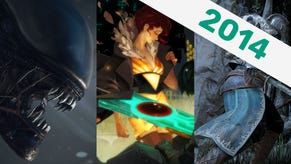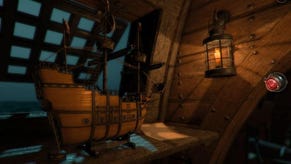Wot I Think: The Room
[squiggly symbol]
The Room, BAFTA winning mobile puzzling mega-hit, has at last reached the PC in HD glory. I've slid my bottom into the slot on my chair, pressed the button that popped up on my mouse, and rotated my head until it faces the screen, which caused a mechanical whirring sound and the revealing of wot I think:
Obviously, since the Great Decree was established, it’s now been accepted by all who wish to live that Myst was a bloody awful game. As was Riven. And Myst III: Exile. And Uru. And probably IV and V - no one’s ever given me money to force myself to play them. Hateful rubbish, meandering nonsense strung together by obscure puzzles, existing only because of the curse of the CD-ROM on PC gaming. That’s just a fact.
The Room is the game Myst should have been. The Room is, I state with absolute conviction and abundant evidence, the game people who thought they enjoyed Myst pretended they were playing, but it turns out was entirely in their imaginations rather than in the miserable Power Point presentation in front of which they were actually sat.
The Room is a beautiful presentation of rendered graphics, sewn together with intricate, engaging puzzles. Myst was a slideshow of Vaseline-smeared tedium over which Z-list non-actors burbled inane claptrap about magic books.
That’s not to say there’s no inane claptrap in The Room. It’s just kept to a minimum, tucked away in entirely ignorable notes. The core game is exploring one enormous, impossibly elaborate puzzle box, hunting for switches, slides, keys and codes, to pick your way through puzzle after puzzle, each opening another section, unlocking new challenges, and constantly making you feel like a proper clever-clogs despite never actually doing anything all that clever.
The game has been around for a couple of years, first on iOS, then eventually Android. This PC version is an almost entire remake (according to the developers, Fireproof Games), apparently requiring nearly every asset to be rebuilt in order to create an HD, PC-worthy version. And by crikey, it’s beautiful. It’s genuinely astonishing at times, as the mechanical parts of the box slide so elegantly, surfaces rearranging themselves, objects raising and lowering, all utterly wonderfully. Just staring at the animations is reward enough for solving any puzzle it offers.
That really is all the reward there is, but it’s genuinely enough. The story, something about some chap trying to discover some mystical ether element thing, is utter guff, and ultimately goes nowhere at all. In fact, this PC build includes the mobile version’s DLC tacked onto the end, creating a stuttering finish that makes even less sense when played as a whole. The only reason it exists is to add a justification to the game’s peculiar twist, a magic lens through which alternate versions of reality can be seen. Which tends to boil down to: if you can’t figure out what to do next, you probably forgot to look at stuff through the lens.
Invariably this involves revealing hidden scrawl, codes, or creating a repeating geometric shape that has mystical connotations to something, somewhere. And while it takes nothing away from the game, I still can’t help but wish for a version of The Room that relied only on its near-believable mechanical wizardry, rather than, well, actual wizardry. The lens gives the game design carte blanche to impossibly change the materials by magicky magic, and this always feels cheap when compared to its wondrous flips, twists and clunks as it rearranges itself before you.
That thing about feeling like a clever-clogs. Something I especially like about The Room is it’s never needlessly obscure. In fact, it’s almost never difficult. It’s just constantly involving. If you get stuck, it’s likely because you’ve not noticed a teeny switch, or forgot to check the lens, and the in-game hint system will gently nudge you if you ask. But it’s not likely because a puzzle is over-complicated or just plain impenetrable. As someone who’s suffered a lot of badly implemented or plain obtuse puzzles in lazy adventure games, some of the challenges prepare me to groan, before realising that – oh – I just do this, this, then this, and yes! Click! I’m a clever-clogs! Even the ominous threat of a sliding tile puzzle quickly reveals itself to be a simple, quickly dismissed affair.
At £4, the two to three hours it should take (boasting of completing it more quickly only reveals a person to be a goof-face who doesn’t take the time to appreciate the beautiful art) is great value. (Although it must be noted the SD version currently costs just 69p on Android/iOS.) It doesn’t amount to anything, it doesn’t go anywhere, and it’s worth noting it lacks The Room 2’s genuinely haunting horror moments. (Presumably we can hope for The Room 2 on PC some time in 2016.) But what it is is entirely worth having: a sumptuous, decorative creation. And it sure isn’t Myst.










